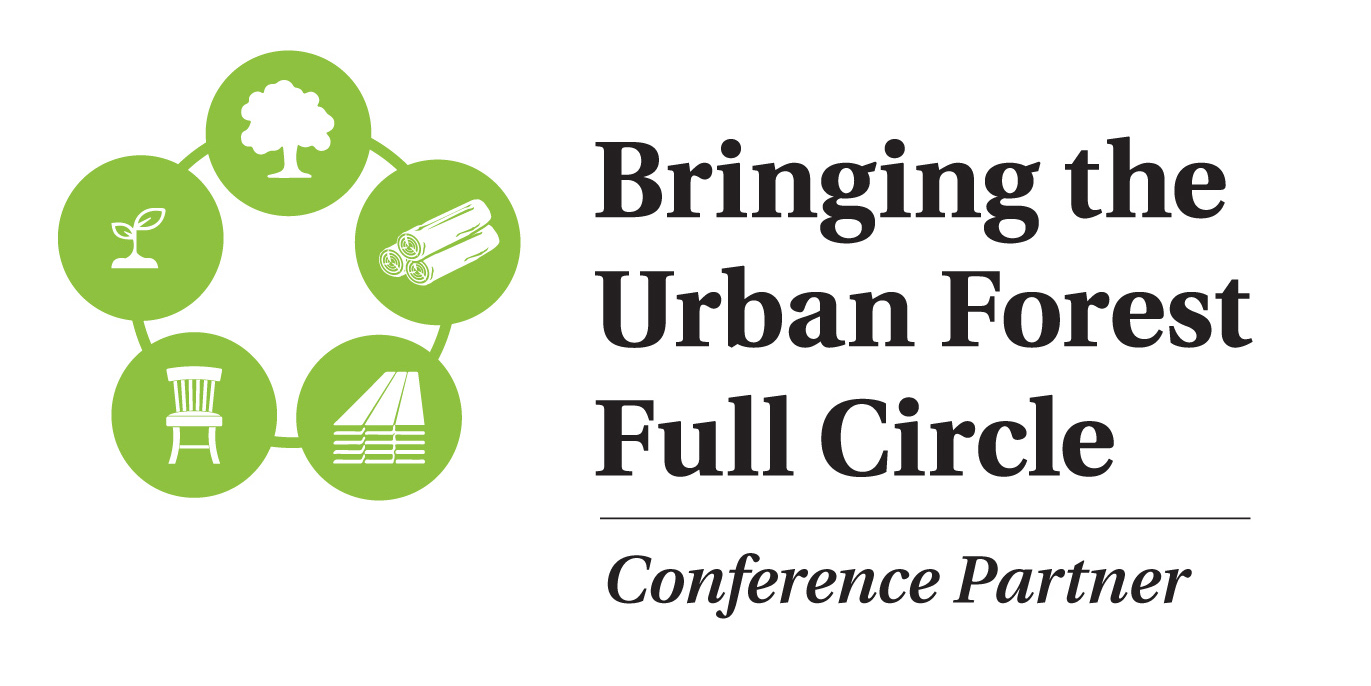 Leap year does not come around very often – only every four years. Therefore, this auspicious occasion might be a great time to leap into some sustainability projects for your home or business! Here are a few sources to get you started: Continue reading “Leap into Sustainability”
Leap year does not come around very often – only every four years. Therefore, this auspicious occasion might be a great time to leap into some sustainability projects for your home or business! Here are a few sources to get you started: Continue reading “Leap into Sustainability”
Assay of Archaeological Find Reveals Desperate Times for the Sick in 1850
ISTC NEWS

Early American ‘Medicine’ Probed by Archaeometry
Life was hard in 1850. Tuberculosis (consumption) was rampant, and one was likely to be dead by 40. The tubercle bacillus was not discovered until 1882, and was not treatable until the early 1940s. By 1900 more than 80 percent of the U.S. population was infected before age 20.
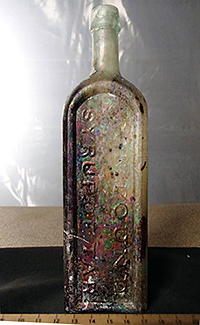
A ‘medicine’ bottle discovered by Illinois State Archaeological Survey (ISAS) during a dig at Meredosia, Illinois, gives evidence of the desperation they faced. Both ISTC and ISAS are divisions of the Prairie Research Institute.
The contents were analyzed by John Scott, senior analytical chemist at ISTC, revealing a dangerous stew of heavy metals and polyaromatic hydrocarbons (PAHs). Scott presented his findings Feb. 19 during ISAS’s Fourth Ancient Technologies and Archaeological Materials Symposium at the University of Illinois.
The bottle, labeled “Thomson’s Compound/Syrup of Tar/For Consumption,” came from a the excavation of a house cellar yielding artifacts from the 1840s and 1850s.
News articles and advertisements of the time are replete with testimonials of ‘health’ and ‘vigor’ from drinking the compound. Many patent medicines contained a lot of alcohol, which would have been needed to keep the other ingredients in suspension, Scott suggested.
The analysis showed compounds consistent with coal tar, pine tar, and essential oils suggesting cumin and thyme. All 16 priority PAHs, now
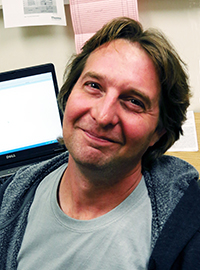
regulated by the U.S. EPA as carcinogens, were present. For comparison, Thomson’s remedy measured a priority PAHs content in concentrations almost three-and-a-half times greater than the mean for crude oil.
Many ‘remedies’ of the era also soothed ‘symptoms’ of various maladies by including opium, morphine, heroin, cocaine, chloroform, methamphetamine, or barbiturates.
Scott found strong evidence that the Thomson’s was spiked not just with alcohol, but also with the active compound in marijuana. High resolution mass spectrometer measurements showed no sign of morphine, cocaine or the other drugs, but demonstrated clear peaks indicating THC (delta9-tetrahydrocannabinol) – which is found in marijuana.
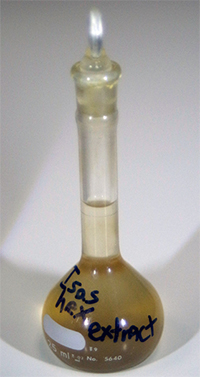
Nine metals were detected in Thomson’s Compound. Arsenic, lead, and iron exceeded levels now considered acceptable for pharmaceuticals. Manganese was close to that limit.
“We can’t know how much of the Thomson mixture was left in the bottle when it was disposed of,” Scott said. “But even if it evaporated from a full bottle, this was a potent brew.”
The name Thomson was synonymous with medicine throughout much of the 19th century, ever since Samuel Thomson succeed in patenting his system of botanic medicine in 1813. Originally a reaction against orthodox medicine, Thomson sought to demystify healing arts for the average man with remedies of natural herbs and extracts. The lucrative field drew many competitors, knock-off artists, and experimenters. For example, a different ‘Samuel Thomson’ was responsible for the Meredosia artifact!
Four Ways ISTC Can Help Your Organization Zero-In on Zero Waste
This article was written by Shantanu Pai for Linked In Pulse.

For over three decades, the Illinois Sustainable Technology Center’s (ISTC) staff of engineers and scientists have provided a variety of cost-effective, sustainable material management services.
ISTC has enabled organizations to improve their environmental footprint and achieve zero waste at every step in their operations by being a resource for innovative management and reuse of materials. We conduct waste audits, assist with materials management planning, supply chain optimization, and stakeholder engagement. These services are part of a subset of our technical assistance program which we refer to as Zero Waste Illinois. The technical assistance program is part of ISTC’s mission to help the citizens, businesses, governments, and organizations of Illinois conserve natural resources, prevent pollution, and reduce waste to promote improved human and environmental health. Here are the ways we can help your organization be part of Zero Waste Illinois.
Comprehensive Waste Audits
ISTC staff design and help implement site specific waste audits ranging in scope from individual buildings to large communities. By analyzing both material inputs and outputs within a facility, we identify more opportunities to help organizations achieve zero waste.
For example, as the result of a waste audit at a mid-sized manufacturing plant in Wheaton, IL, our team was able to make six recommendations which have been implemented. Through our work and a truly energetic internal staff, that facility has achieved 44% reduction of material use through process modifications—”up-stream” changes that make the entire operation more efficient over the long-term, and a new landfill diversion rate of 62%.
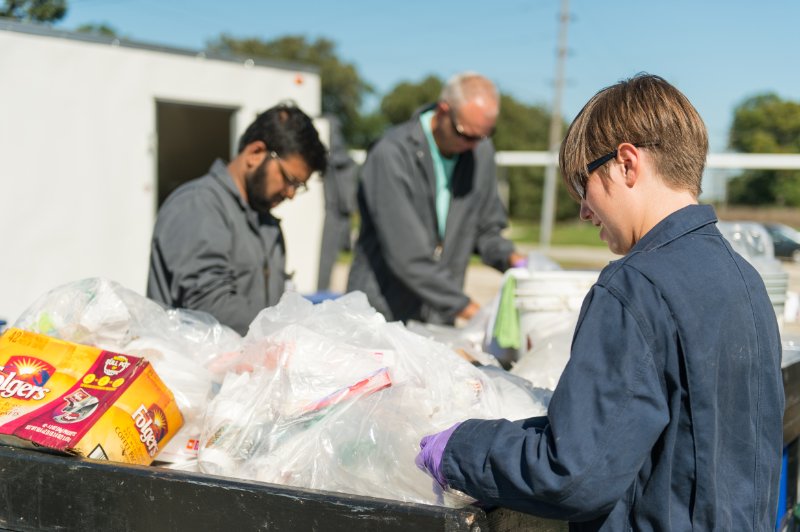
Enhanced Materials Management Planning
We help clients identify gaps in, and opportunities to improve, existing waste management processes. Additionally, we can offer solutions for site-specific constraints that prevent greater waste diversion.
For example, ISTC has been working with the Forest Preserve of Cook County, the nation’s largest forest preserve district with over 69,000 acres, to create a materials management plan for the entire district. Our efforts have resulted in increased recycling opportunities for District users, novel waste contract language and zero waste guides for event planners and the general public, in English, Spanish and Polish!

Composting/Anaerobic Digestion Assistance
We conduct business outreach and research to support food waste reduction and diversion efforts. We assist clients with setting up successful compost programs by conducting waste stream assessments, designing signage, and training employees. We are currently researching a growing number of food scrap technology options, including aerobic and anaerobic digestion, and in-vessel composting.
Stakeholder Engagement
By partnering with employees, students, and communities, we can help you improve existing waste reduction programs through education and training. We provide advice on communication strategies that lead to lasting behavior change.
We recently worked with the University of Illinois, Urbana campus, on multiple recycling and waste reduction initiatives. In the fall of 2014 ISTC managed the Zero Waste football game at Memorial Stadium. With the help of over 150 volunteers and various departments on campus we were able to divert over nine tons of material to composting and recycling facilities.
We also assisted in rolling out a campaign to increase recycling at the Quad through improved signage, location assessments, and directed data collection.
Begin Your Journey to Zero Waste
Learn more about how our team of professionals might help your organization approach zero waste by visiting our web site to view our recent success stories. Then, sign up for a free site visit. There is no obligation on your part to work with us beyond the free initial visit, and that first conversation may reveal opportunities to achieve greater sustainability within your organization.
Have questions? Contact us at istc-zerowaste@illinois.edu.
Shantanu Pai is an Assistant Sustainability Researcher at the Illinois Sustainable Technology Center with a BS from University of Wisconsin—Stevens Point in Waste and Soil Resources. His research interests include fate and transport of waste materials through market driven initiatives; the role of affluence and directed public policy in solid waste management; and solid waste industry in the developing world.
2014 Illinois Governor’s Sustainability Award Winner: Nestle Jacksonville
In early 2013, Nestlé’s Jacksonville environmental network set a goal to have their factory achieve zero waste to landfill by the end of that year. The network worked with representatives from all four beverage factories – Jacksonville, IL, Freehold, NJ, Waverly, IA, and Anderson, IN – and formed the Nestlé Beverage Environmental Network. As a divisional network they worked collectively on solutions to achieve zero landfill status at all four factories.
The projects pursued by the team resulted in:
-
1,029 tons of waste diverted from landfill per year; and
-
$900,000 in annual savings from energy efficient upgrades.
The team also successfully engaged employees at the facility. Half of the efficient installations originated as ideas from factory floor staff.
Read the entire case study here.
Sharma Named Fellow of National Engineering Society
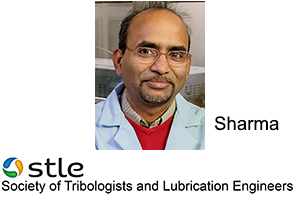
ISTC NEWS
B.K. Sharma, senior research engineer at the Illinois Sustainable Technology Center, has been elected a fellow of the Society of Tribologists and Lubrication Engineers (STLE).
Fellows are selected based on their significant impact on the field. Fellows represent outstanding authorities from industry, academia, and government agencies. Six new fellows were named for 2016 and will be honored at the 71st STLE Annual Meeting and Exhibition May 17 in Las Vegas.
Tribology is a multi-disciplinary field concerned with design, friction, wear and lubrication of moving parts. It is a branch of inquiry which spans mechanical engineering, materials science, surface science and others.
Sharma, a chemist by education, has published 87 publications in international journals, five U.S. patents, nine book chapters, and 133 presentations in international and national conferences. Among his research interests is the development of bio-based lubricants and additives for industrial applications.
What to do with Wood Waste – Research & Conference
 From lumber and paper to building and shipping, wood can be used in a wide variety of ways. But with all those different applications comes many different waste streams including wood itself as a waste product. ISTC has partnered with Western Illinois University and the Metropolitan Mayors Caucus to find new markets for waste wood. Read more about the project via our news page titled “Wood Waste Market Research Could Benefit Illinois Business.”
From lumber and paper to building and shipping, wood can be used in a wide variety of ways. But with all those different applications comes many different waste streams including wood itself as a waste product. ISTC has partnered with Western Illinois University and the Metropolitan Mayors Caucus to find new markets for waste wood. Read more about the project via our news page titled “Wood Waste Market Research Could Benefit Illinois Business.”
In addition, ISTC is pleased to announce that we will be a partner sponsor for the March 18 conference (and March 17 hardwood workshop), Bringing the Urban Forest Full Circle, at Hamburger University in Oak Brook, IL. The conference will highlight opportunities for individuals, businesses, trade groups and public entities to capitalize on the salvage and conversion of community trees into high-valued logs, lumbers and wood products. Plan to join us for this event.
Best Buy Ends Free Recycling of Televisions and Monitors
Last week, Best Buy announced that it would no longer be offering free recycling of televisions and monitors through its in-store collection program. The retailer is now charging a fee of $25 for each TV or monitor–whether they are flat screen or the older, bulky CRT monitors that contain leaded glass–in most states.

According to the announcement, in Illinois and Pennsylvania, “we are no longer recycling these particular products because of laws that prevent us from collecting fees to help run our program. All other products – such as batteries, ink cartridges, computers, printers and hundreds of other items – continue to be recycled for free at all of our stores.” However, there is an exception to this complete discontinuation of the company’s recycling service for these products in IL, as noted in the latest version of the Electronics Recycling Guide for Residents of or nearby Champaign, County, IL: “If a Best Buy customer purchases a 55″ or larger TV from Best Buy and has it delivered to their home, then Best Buy will take back one TV for recycling. Or, a person may sign up at Best Buy’s home theater section, pay $100 for a television pick-up, and then Best Buy would arrange to pick-up and recycle a TV from a residence.” (Thanks to Susan Monte of the Champaign County Regional Planning Commission and Courtney Kwong of the City of Urbana for this information. It should also be noted that the Champaign County Regional Planning Commission is also seeking approval and authorization of funds to host county electronics collection events in the spring. Decisions regarding such funding will be made later this month, and if county collection events are scheduled, information on those collections will be shared on the Sustainable Electronics Initiative web site.)
Best Buy has been a leader in offering electronics recycling for many years–it has collected more than a billion pounds of electronics and appliances since 2009. The company’s leadership will continue in terms of recycling other consumer electronics, but recycling is driven by commodity prices. Old cathode-ray tube (CRT) monitors were surely a large part of the TV and monitor recycling stream coming into Best Buy stores, and since these monitors aren’t really manufactured any more, there’s less demand for the leaded glass they contain. This makes handling these hazardous materials a costly prospect for recyclers, and as time goes on, more and more recycling programs are ceasing the acceptance of monitors and TVs, or adding restrictions.
However, CRTs aren’t the only issue here, as Resa Dimino, Senior Advisor for the Product Stewardship Institute, pointed out in an opinion piece for Resource Recycling this week. Best Buy is charging for flat screens as well, so its clear that costs associated with recycling those types of devices are also proving too much for the retailer to continue to offer for free nationally. This counters the argument made by some that once the problematic CRTs have been cleared from the system, electronics related Extended Producer Responsibility (EPR) laws that hold manufacturers responsible for safe and proper disposal of their products, will no longer be needed as the value of other materials in the recycling stream covers the costs of collection and processing. Dimino further notes that EPR laws are only effective when they’re fair and equitable–flaws in current legislation allow some manufacturers to step back while a few manufacturers and retailers (like Best Buy) take up the slack, shouldering more than their fair share of financial responsibility for sustainable management of materials. Also, local governments cannot afford to pay for provision of electronics recycling to residents. All of this suggests, according to Scott Cassel of the Product Stewardship Institute, “it’s time to revisit the nation’s 25 state e-scrap laws to ensure that all manufacturers are equally responsible for electronics recycling.”
Barbara Kyle of the Electronics TakeBack Coalition suggested the following in her blog post on Best Buy’s recycling policy change: “The solution here would be for the manufacturers – particularly the TV companies – to visibly partner with Best Buy to cover some of the recycling costs, and to make sure that responsible recycling occurs. The TV companies, who are always challenged by finding collection sites, could take advantage of the chain’s huge network of stores, which are very convenient collection points for most consumers. This would be an ongoing national partnership program, in every state, in every store, co-marketed by the retailer and the industry. This could also be established with Walmart and their huge network of stores. While Amazon doesn’t have stores, there are many ways in which they could help to be part of the solution.” Perhaps if there is pressure from consumers on electronics manufacturers and other big retailers, this sort of scenario could happen.
For more information on the stewardship of electronics and other consumer products in our state, see the Illinois Product Stewardship Council web site. Also see the IL EPA site for information on our current state electronics recycling law.
This post originally appeared on the Sustainable Electronics Initiative Blog.
Sen. Durbin Backs Research to Capture More Carbon from Coal Plants
Senator Richard Durbin (D-Ill.) toured the Abbott Power Plant at the University of Illinois on Jan. 15 for a briefing on Prairie Research Institute (PRI) research to develop next-generation carbon capture technology.
PRI has just released an informative video introduction to the work underway at the Abbott Power Plant.
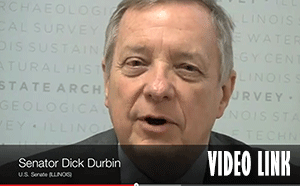
The first-hand look at the project was an “eye opener,” Durbin said. If selected for the federally funded project, the technology would economically extract at least 90 percent of the carbon dioxide following an Abbott Power Plant retrofit. The ramifications for coal-rich Illinois – for jobs, the economy, and keeping utility rates low – could be profound.
“What’s going on here at the Abbott Power Plant is an effort to show that there is an environmentally responsible way to deal with the sources of energy whether they’re coal, natural gas, or oil,” Durbin said after the tour. “We’re working with the university, and the power plant, on an application for a Department of Energy research effort; and their goal, of course, is to take even more of the emissions and turn the pollution into profits and make certain that it doesn’t at least harm the environment in serious ways.”
For many nations around the world where coal is likely to remain the fuel of choice well into this century, the new technology could be a game changer in the challenge to limit global warming. The project includes expert advisory panel representing some of the largest power producers around the world, including China, India, and Brazil, said Kevin O’Brien, director of the Illinois Sustainable Technology Center and primary investigator for the project.
“We’re living in an era of dramatic change,” Durbin said. “Ten years ago we depended on OPEC oil. Now we’re talking very seriously about climate change and the need to reduce emissions.”
 He praised the efforts at the University for keeping the more than 70-year-old plant at the forefront of efficient and effective technologies to deliver both steam and electric power to students and staff. “It still serves the campus today,” Durbin remarked. “The good news is that over the years there have been some dramatic efforts to modernize this plant and to make sure that it not only meets the standards but goes beyond, and sets the standard for new technology and new energy development.”
He praised the efforts at the University for keeping the more than 70-year-old plant at the forefront of efficient and effective technologies to deliver both steam and electric power to students and staff. “It still serves the campus today,” Durbin remarked. “The good news is that over the years there have been some dramatic efforts to modernize this plant and to make sure that it not only meets the standards but goes beyond, and sets the standard for new technology and new energy development.”
“So it was good to see this first hand today — to be educated. I will tell you that it came as an eye opener to me. The steam generation and how important it is to the University of Illinois and also very important to generate the kind of electricity that sustains a modern campus in the 21st century.”
The project would put Abbott well beyond existing standards for emissions control. Abbott’s current pollution control technology, consisting of a combination of electrostatic precipitators and a flue gas desulfurization unit (scrubber), remains the “best available control technology” for removing pollutants from the byproducts of coal combustion.
The carbon capture research project also will look ahead to developing new uses for waste carbon dioxide. The project seeks partners interested in forming and building the overall “value chain” for captured CO2 – including members/ suppliers to the coal and power industry, and current and potential end-users of CO2. To learn more about the opportunity, call +1 (630) 472-5016.
Green Your Office, Join the Challenge
 Registration is now open for the 2016 Illinois Green Office Challenge (IGOC), a friendly competition to see which Illinois organization can accumulate the most points by conserving energy and water, reducing waste, and saving money.
Registration is now open for the 2016 Illinois Green Office Challenge (IGOC), a friendly competition to see which Illinois organization can accumulate the most points by conserving energy and water, reducing waste, and saving money.
The competition will launch with a kickoff and informational session at 4:30 – 6 p.m., Thursday, Feb. 25 at the Illinois Sustainable Technology Center (ISTC), 1 Hazelwood Drive, Champaign.
Last year the Challenge began in the Central Illinois communities of Champaign-Urbana, Peoria, and Bloomington-Normal. The U.S. Army Corps of Engineers, Construction Engineering and Research Laboratory in Champaign was the highest scorer in the region. This year offices statewide are encouraged to sign up.
Contestants can start piling up points Tuesday, March 1, as they begin to score points for completing specific sustainability activities at their facilities.
Money-saving ideas and assistance will be provided by ISTC, a division of the Prairie Research Institute at the University of Illinois at Urbana-Champaign.

The Challenge website provides participants with the information and tools they need to compete and complete activities, and a live leaderboard will track their scores, as well as those of other competitors from across the state. At the end of the Challenge, participants will be acknowledged for their hard work through media, peer recognition, and year-end awards. The Challenge welcomes all public and private buildings that are used primarily for office space.
There is an administrative fee of $50 for registration, but it can be waived if it is a barrier to participation. Questions can be directed to Bart Bartels: bbartel@illinois.edu.
A Peoria-area kickoff is scheduled for Thursday March 3. Additional community meetings and informational workshops will be scheduled as organizations and communities sign up. For complete information, visit the IGOC website at https://www.illinoisgoc.com/.
ISTC Signs Call for Action to Limit Global Warming
ISTC NEWS
 The Illinois Sustainable Technology Center (ISTC) has become a signatory to The Paris Pledge for Action, a world-wide call to action to reduce environmental impacts and limit global warming to less than two degrees.
The Illinois Sustainable Technology Center (ISTC) has become a signatory to The Paris Pledge for Action, a world-wide call to action to reduce environmental impacts and limit global warming to less than two degrees.
“Minimizing the impact of climate change will require global innovation and cooperation,” said Kevin O’Brien, director of ISTC at the University of Illinois’ Prairie Research Institute (PRI). “There is not one solution to this societal, governmental, and technological challenge,” he added, “there are as many as we can think of.”
COP21, also known as the 2015 Paris Climate Conference, was the United Nation’s 21st climate conference in December, at which 196 nations recognized that climate change represents an “urgent and potentially irreversible threat to all human societies” requiring “deep reductions” in global greenhouse gas emissions.
The Paris Pledge for Action offers cities, businesses, investors, organizations and others everywhere to pledge to impact the goal of halting the rise in the average annual temperature on Earth. It is an initiative of the COP21 French Presidency (diplomatic host of the Conference) and the University of Cambridge Institute for Sustainability Leadership.
The pledge also reads: “We … realize that taking strong action to reduce emissions can not only reduce the risks of climate change but also deliver better growth and sustainable development.”
Researchers at PRI have partnered with the U.S. Department of Energy on its technology roadmap on two approaches to perfect systems that can remove a record proportion of carbon dioxide from fossil fuel energy (especially coal used to generate electricity). With a Phase I DOE grant the team is currently investigating the engineering requirements to install ground-breaking technology at the U of I’s Abbott Power Plant. A second grant is developing a unique bi-phasic solvent as an ultra-efficient carbon capture technique.
“Our mission includes research, technical assistance, and public information to help forge a more sustainable future,” O’Brien continued. “The new technology, and our partners, span three continents and some of the largest power generators in the world so that our findings can quickly have the greatest impact on our Pledge for Action.”
For more on the PRI research, visit http://www.istc.illinois.edu/news/news26_carbon_capture.cfm and https://illinois.edu/blog/view/6231/314236.


